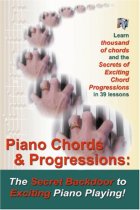How To Play “Michael Row The Boat” Using Just 3 Chords & Lots More
How To Play “Michael Row The Boat”
| Good morning. This is Duane. We’ve been exploring some songs that you can play with just 3 chords but you don’t have too. Today we’re going to look at Michael Row The Boat Ashore, very simple song that a beginner could pick out. Let me just play the melody and show you how few notes there are in it … [music 00:00:19] So far we’ve just had 1, 2, 3, 4 notes, right? Again … [music 00:00:29] 5 note, 6 notes. We just have 6 notes from C up to A by starting on C. Now we know that the 3 primary chords in the key of C are the C chord, the F chord, and the G chord. Now I’m playing the F chord and the G chord upside down in an inversion, but they are still the same 3 notes; for example that’s the F chord but it’s not in root position, it’s not F’s on the bottom. That’s for ease of my hand, so the hand can move much easier from there to there than it can from there to there, you see, and it’s much smoother, too.
|
| Then to the G chord, I’m playing it in first inversion with the B on the bottom but the same 3 notes, just 3 chords: C, F and G. Now I’m going to harmonize it with the melody … [music 00:01:27] I can play it with just 3 chords but do I have to? No, of course I don’t. I could ask myself into what other note any melody note fit? For example, the melody note there is G. It’s in the C chord, right? That’s what I played the first time but it’s also in the G minor chord, it’s also in the E minor chord, it’s also in the E flat major chord, it’s also the 7th of the A flat major 7th chord and so on. I can ask myself … so I’m just going to pick E minor … [music 00:02:14]. There, instead of going to C I use the A minor 7th chord because G is part of the A minor 7th chord. Already I’ve just used 2 other chords that make it a little more interesting. [music 00:02:31]
|
| I’m using the F chord but I’m putting a major 7th in it and going to the 6th. There I’m using a C chord but I’m using a 9th going to the root and a 7th coming up to the root [music 00:02:52]. There’s a A minor chord. There I can use A 7th, say … [music 00:03:02] That’s D 7 suspension resolution. G minor 7th suspension. G 7 with the flat 9th and home to C … [music 00:03:15] and on and on. You see just by using other chords, other than those three basic chords. Again, the formula for that is just to ask yourself at any point in the melody, what other chord will fit in the melody? If the melody is G, just ask yourself: Let’s see if it’s … G is in the C chord but it’s also in the G chord, so I could use G. It’s also in the G minor chord so I could use G, G minor. It’s also in the F major 9th chord and so on. The more chords you know the better because you have more choices that way.
|
| Okay, that’s it for today and tomorrow we’ll take up another tune like that and see if we can’t get into arranging simple songs fairly complexly on a fairly easy basis. Thanks for being with me and if you’re not already signed up for our series of videos and new letters go on over to playpiano.com and do that. We’ll see you there. Bye bye for now.
Click on this link to watch this video on YouTube: https://www.youtube.com/watch?v=gZsYZQRdOLk&feature=youtu.be ***For lots more good stuff on piano playing come on over to my website at https://www.playpiano.com and sign up for our free piano tips – “Exciting Piano Chords & Sizzling Chord Progressions!” Here’s a great little book on chords and chord progressions on Amazon: http://www.amazon.com/Piano-Chords-Chord-Progressions-Exciting-ebook/dp/B0076OUGDE/ref=sr_1_1?s=books&ie=UTF8&qid=1404158669&sr=1-1&keywords=piano+chords+duane+shinn ÂÂÂÂÂÂÂÂÂÂÂÂÂÂÂÂÂÂÂÂÂÂÂÂÂÂÂÂÂÂÂÂÂÂ____________________________________________________________________________________ |




